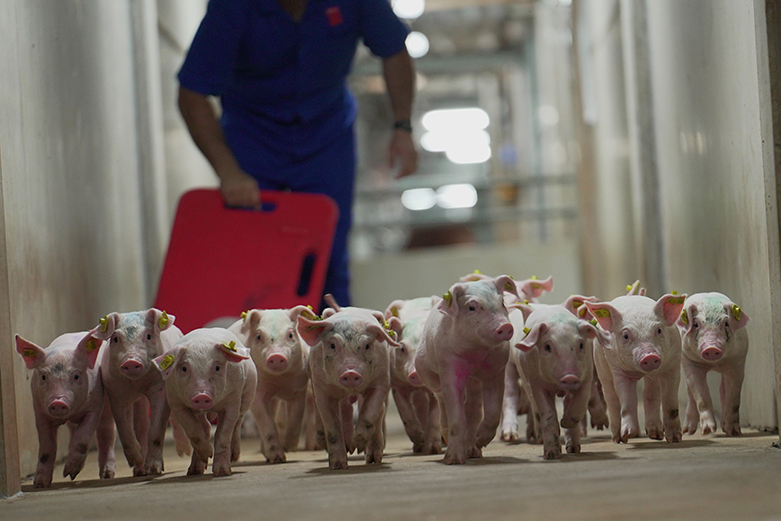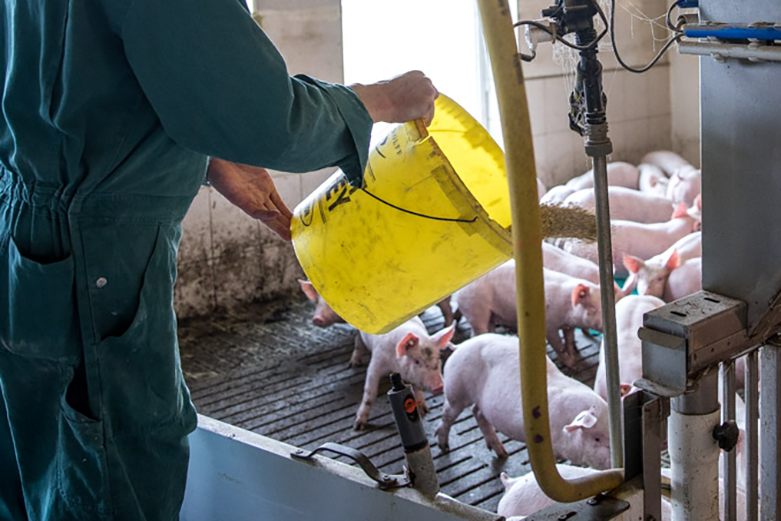WEANING OF PIGS: OPTIMAL MANAGEMENT AND NEW CHALLENGES – an 8-part series
- What happens at weaning
- Objectives at weaning in the sow
- Management of the dam and piglet during weaning
- Housing the piglet after weaning
- Feeding of the sow
- Piglet feeding at weaning
- Age at weaning
- Types of weaning according to the age of the piglet.
The authors:
Emilio Magallón Botaya – Veterinarian specialising in Economics and Pig Production.
Sara Beitia Delgado – Agronomist Engineer – La Almenara Farm
Pablo Magallón Verde – Technical Service PIC
David Roldan Feringan – Veterinarian-Granja La Almenara
Patricia Prieto Martínez – Veterinary Service Inga Food
Images provided by the authors
Weaning is a very important part of the life and production cycle of animals. From the piglets’ point of view, among other aspects, it involves separation from their mother and a change in the composition of their feed. In turn, a series of hormonal changes are triggered in the sow, which will mark the beginning of a new production cycle.
In this series articles we will try to answer all the questions that are often asked about weaning and the best way to carry it out. Firstly, to answer the most frequently asked question “What is the best age for weaning”, we must review the characteristics of each farm: genetics, facilities, management, feeding, personnel, legal conditions, etc., because not all farms can use the same weaning system, nor can we wean at the same age.
What happens at weaning
For a correct management of the animals at weaning, it is important to know the nature of the piglet and the changes it undergoes, as well as to carry out certain actions with the mothers to ensure its optimum condition for the following gestation.
What is weaning in a natural environment like?
The weaning process in the wild pig (wild boar) is gradual, so that the young wild boars progressively move from an exclusively milk diet to a diet without milk. As the offspring grow, their nutritional needs change and increase. In addition, the sows milk production decreases and is insufficient to meet the needs of its young. Gradually, the pigletsbecome familiar with solid food. Lactation in wild pigs lasts 8 to 12 weeks. Although some authors extend it to 12-17 weeks.
What happens in the sow at weaning?
At weaning there is an important physiological change in the sow, which goes from producing milk to restarting the oestrus cycle. This effect is caused by the suppression of prolactin hormone production due to the cessation of suckling by the piglets, which initiates the oestrous cycle.
As soon as the sows are weaned, it is important to manage the “teaser” boars in a way that favours the male effect. Weaned sows must have daily contact with the boar. The sows will come into oestrus from 3-6 days post-weaning, and will be inseminated from that time onwards, as they come into oestrus.
Weaning of the wild boar
The gradual process of dietary change in wild boar occurs in four phases:
1. Hiding
- It lasts for the first week.
- The piglet remains isolated in the nest built by its mother and makes sporadic excursions around the nest.
2. Familiarisation
- Second and third week of lactation.
- The piglets leave the nest and follow the sow. They stay with their social group and start rooting. There is hardly any contact with other litters.
3. Integration and learning
- From the third to the seventh week.
- The sow leaves the piglets alone for long periods, the interval between feedings increases and the feedings become shorter and shorter. They interact with other piglets in their social group and forage for food.
4. Independence
- From the seventh week to 12-17 weeks of lactation.
- Nursing becomes less and less frequent until it ceases at a certain point. The piglets gradually stop suckling, function independently of the mother although they are still part of the social group and sleep next to her.
This is the Wean to Service Interval (WSI), which represents the time it takes for a sow to become fertilised measured from the date of weaning. It is a very important parameter to determine the reproductive efficiency of a sow. In order to promote ovulation, it is advisable, especially in thin sows, to carry out a so-called “flushing” or overfeeding from weaning to service.
It is important to classify sows at weaning according to their body condition, in order to be able to apply different feeding curves according to their condition, so that thin sows improve their body condition and fat sows do not put on more weight than is advisable.
How does the piglet react when it is weaned?
Stress
Weaning is a very delicate and stressful time for the piglet, as it undergoes a series of important and abrupt changes:
- Loss of maternal protection and sudden separation from its mother.
- Interruption of the transmission of antibodies from the mother to the piglet through the mother’s milk, with the consequent loss of maternal immunity. The so-called immune window occurs, which makes the piglet susceptible to pathological problems in the post-weaning period (figure 1).
- Change of rearing site, almost always by transport, sometimes over long distances.
- Frequent changes of rearing partners, becoming part of larger groups than the original litter, with consequent fights to re-establish the social hierarchy.
- New feeding systems, new hoppers and drinkers with mechanisms that require learning and handling.
- Abrupt change from hot, liquid to cold, solid feeding. Less digestible diets.
- Increased water requirements.
- Major changes in feed supply: they go from eating in suckling cycles every 40-60 minutes, to having ad libitum a feed that most of the time they have hardly tasted (sudden contact with vegetable protein).
It should be kept in mind that, under natural conditions, weaning is a gradual process and takes place at a later age, when the piglet is physiologically more mature. For this reason, stress on the piglet during this process should be minimised and environmental and management conditions should be controlled.
Figure 1: The waning of maternal immunity and the emergence of acquired immunity: immune window.

Graph taken from “Manejo y gestión del posdestete. El lechón destetado”.
Digestive and feeding problems
Possibly the most important effect of weaning stress is the reduction of feed intake. As a consequence, the piglet suffers from the well-known “post-weaning syndrome” which is characterised by:
- Morphological changes in the intestinal microvilli which shorten and crypt size increases (figure 2).
- Enzymatic changes caused by dietary changes. After weaning, saccharase and maltase activity increases and lactase activity decreases.
- Changes in microbiota: bacterial diversity increases after weaning and its composition changes.
It should be noted that in a healthy animal the microbiota of the digestive tract is relatively stable. It has the presence of beneficial bacteria such as Lactobacillus and other harmful bacteria such as E. coli. Sudden changes in diet, stress, etc. lead to a reduction in the number of Lactobacillus and an increase in the number of other harmful bacteria, such as E. coli. This favours the colonisation of other highly pathogenic agents, such as rotavirus, which can be the origin of diarrhoea and poor nutrient absorption.
In recent years, the term gut health is being widely used. This state is achieved by a balanced and palatable feeding programme in the post-weaning phase to avoid diarrhoea. For this it is very important:
- Knowing the dietary risk factors at weaning.
- Adapt feed to the physiology of the piglet.
- Try to achieve high feed and water intakes as early as possible.
- Weaning piglets at an appropriate weight and age (this is the most important factor).
Latency period
From the beginning of weaning, a high and regular feed intake by the piglet is necessary to ensure the integrity of the intestinal microvilli. In the first days the feed intake should be at least 150 g/day, so that the piglet can maintain its body mass reserves. It is common that the piglet loses weight in the first days because it takes too many hours to start eating. This period is referred to by some authors as the latency period. It is the time from weaning until the piglet reaches a regular feed intake.
There are large individual variations in the feeding behaviour of piglets. In general, they have a very inquisitive behaviour, so they will quickly explore the whole pen and find the hopper. It is therefore very important that they have learned to eat feed in the farrowing pen, or at least are familiar with it, even if feed intake at this stage is minimal.
Figure 2: Representation of the alteration of the component cells of the intestinal microvilli. The ingestion of inappropriate food leads to accelerated multiplication of germ cells, which causes the elimination of absorptive cells and thus impairs the absorption-excretion of nutrients and water into the intestine. A: Intestinal lumen; B: Crypts; C: Mucosa.

Figure taken from “Manejo y gestión del posdestete. El lechón destetado “.
It is also important to know the feeding patterns of piglets at post-weaning to understand this process. If they find the feed, most will try it, although the amounts ingested will be minimal. Only after confirming that the feed is safe, they will consume it in normal amounts and adopt a regular feeding pattern. Clearly piglets that were already familiar with the same feed in the farrowing pen will acquire this pattern of intake earlier (figure 3). There is also a small percentage of piglets, between 5 and 10 %, that suffer from so-called food neophobia. These piglets have a first taste of feed at weaning, but then refuse feed for days afterwards.
Fluctuations in feed consumption cause the piglet’s digestive microbiota to become unbalanced and pathogenic bacteria such as E. coli proliferate, leading to diarrhoea and digestive problems such as oedema disease.
Figure 3: Visits made by piglets in feeding station, with and without access to starter feed, in lactation.

Figure taken from “Manejo y gestión del posdestete. El lechón destetado”.
Figure 4: Distribution of the number of live births per farrowing on a farm with hyperprolific sows.

To minimise the latency period, it is very useful to place a round hopper inside the pen, as it is similar to the one in the farrowing pen, and many piglets will learn to eat by imitating the others and will eat in a group as they do in lactation.
Sociability and hierarchy
Pigs in the wild live in family groups that establish a hierarchical social order where there are usually no problems of aggression, unless the group is destabilised or there are problems of space or food.
Why is this behaviour not maintained on farms?
- Lack of sufficient space to respond with submission to a threat.
- Competition for feed.
- Frequent disruption of hierarchies caused by mixing of pigs from different social groups, as usually several litters are not put together in the same block, but animals are regrouped by weight and sometimes also by sex.
The social pecking order is re-established within the first 48 hours. Although it is not always fixed, if there are no changes due to the introduction of dominant animals into the group, the overall structure remains unchanged. When competitive situations arise, such as food restriction or lack of space, animals of lower or intermediate rank may be disadvantaged.
These stressful situations and/or fights lead to a decrease in production parameters such as average daily gain or feed conversion ratio, as well as to an increase in injuries.
This series of articles was first published in the professional journal SUIS.



